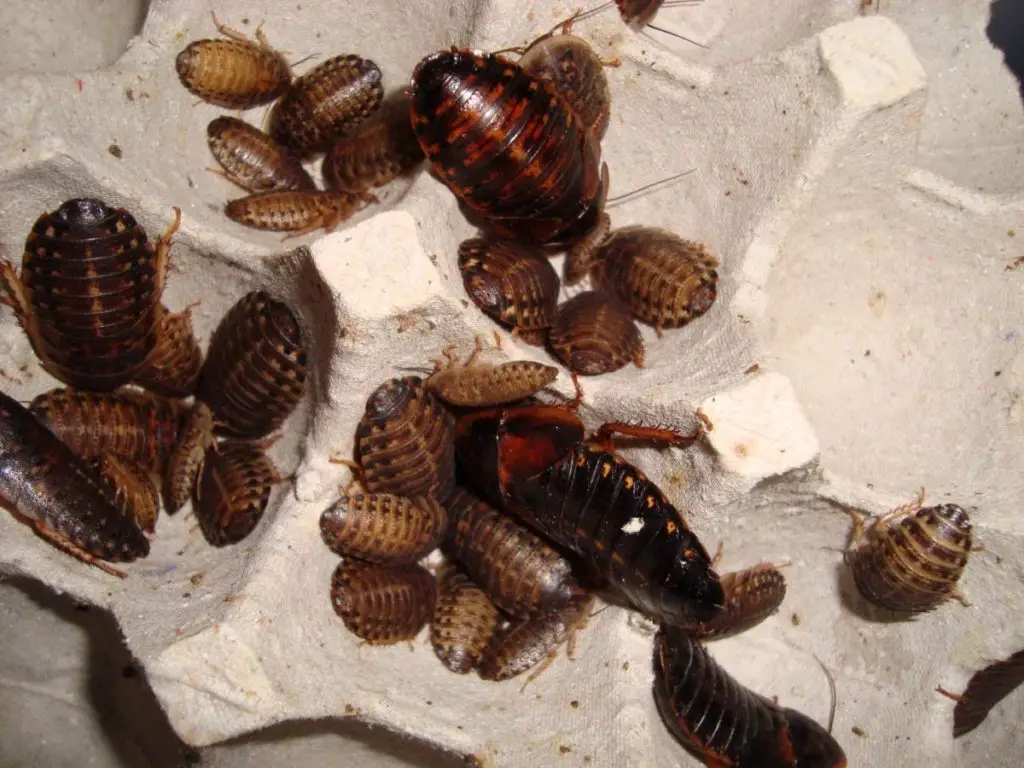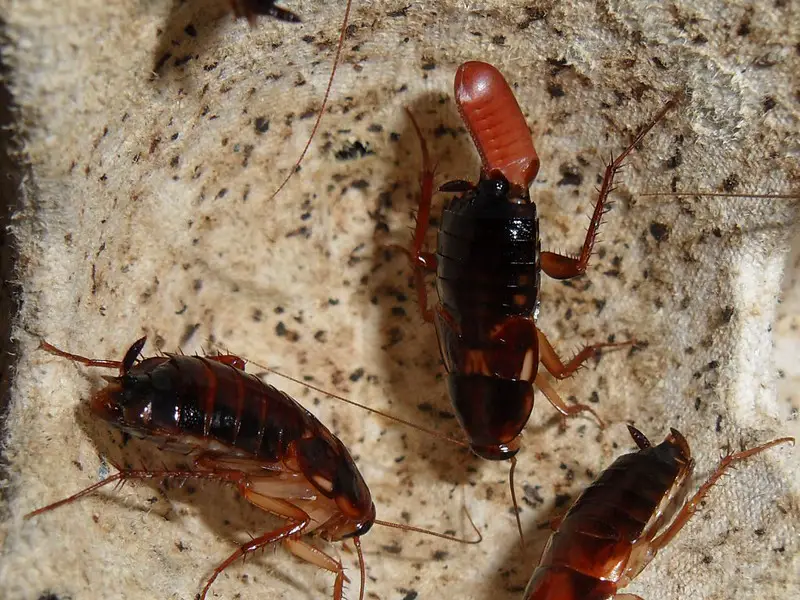Dubia cockroaches, also known as Blaptica dubia, are often used as feeder insects by many exotic pets hobbyists. Here’s a guide on how to breed a colony of feeder Dubia roaches for your exotic pets, which can save you a lot of money and time in the long run.
To keep and breed Dubia roaches, house them in a ventilated, opaque tank. Apply 3″ wide vaseline on the inner wall and fill the container with egg cartons. Place a water dish, and feed the roaches with vegetables and biscuits. Remove unconsumed food after regularly, and clean the tank every month.
Roaches are one of the hardiest creatures in the world. It was said that they can even survive the apocalypse. This tells you how easy they breed and propagate. Let’s dive into more details on how to keep and breed Dubia roaches.
Why Roaches Instead of Crickets?
While crickets are far more common feeders than roaches, roaches have been steadily gaining popularity.
Compared to the short-lived crickets, roaches can live for more than a year. On top of that, they are hardier than crickets. You won’t see as many carcasses when rearing roaches as you would with crickets, which means lesser cleaning.
Lastly, roaches don’t jump, making them easier to handle.
Enclosure
Get a storage box with a lid. A 10 gal storage box can easily house more than 400 roaches.
Drill multiple holes with a diameter of around 0.05 – 0.1” (~1.5 – 2.5 mm) on the lid for ventilation. The more vents you drill, the better it is because roaches prefer a drier environment.
Then, apply a 3 – 4” wide vaseline along the upper, inner wall of the storage box. This will prevent the roaches from crawling onto the underneath of the lid and escape when you open the lid. It also prevents the smaller roaches from escaping through the vents.
I came across an innovation using electrical current to zap the roaches when they step into the restricted zone. This allows commercial breeders to keep the lid off for better ventilation. It might be too much for hobbyists but you can explore that if you are interested.
Stack egg cartons or corrugated cardboard (folded zig-zag) and place them vertically in the storage box. The height of the cardboard should be lower than the vaseline stripe.

Roaches like to stay in a narrow space with something touching their back. Those cartons/cardboards will give them extra security while increasing the surface area in your storage box so that you can house more roaches.
Keep the enclosure somewhere safe.
Substrate
Roaches don’t really require substrates. You can line a few pieces of old newspapers at the bottom of the storage box to absorb their dropping. Alternatively, you can put some sawdust or dry hay as substrates.
Food
Cockroaches can feed on a variety of things. You can give them bread, biscuits, hard boiled eggs, vegetables or fruits. Put the food into a dish so that it is easier to clean up.
Unconsumed wet food should be replaced once every 2 – 3 days while dried food can last longer. Try to adjust the amount of food given so that your colony can finish them within 2 – 3 days. This will ensure the food is always fresh for the roaches and minimize pest infestation or mold.
Water and Humidity
All living creatures need water to survive, so do cockroaches. Prepare a water dish and put a sponge on it. This allows the roaches to drink water from the sponge and prevent the young nymphs from drowning. Keep the sponge wet and wash it every week.
Unlike many other insects, you don’t need to mist the cockroach enclosure to give them extra humidity.
Temperature
The growth of the roaches benefits from a higher temperature. The table in the earlier section has listed the optimum temperature required to rear the 2 species of roaches.
The growth rate of roaches increases as the temperature increases. However, once it reaches the highest end of the optimum range, the growth will be retarded and the roach will die from overheating.
Conversely, the roaches’ growth will slow down as temperature decreases, and eventually they will die if they are under the minimum tolerable temperature for a prolonged period of time.
If you need to regulate the temperature, use a heat mat. You can also shine a high wattage light onto the storage box to warm up the box, only if the box is not transparent because roaches prefer to stay in darkness. Be sure to monitor the temperature so that your roaches are not fried by the extra heat.
Breeding Dubia Cockroaches

Roaches can start breeding about a week after they turn into adults. If you buy a group of roaches, you will have male and female roaches for sure.
The sex of roaches can be easily identified by looking at the tip of their abdomen. Female roaches have a pair of cerci near the tip of her abdomen while the male roaches have another pair of styli between the cerci.
On top of that, female adults of Dubia roaches have under-developed and much shorter wings than the male adults.
Almost all roaches lay their eggs in an egg case called the ootheca. Dubia roaches keep and incubate the ootheca in their body until the eggs hatch. Some species (eg. Turkistan roaches hide their egg cases at somewhere safe. Others may carry the ootheca with them and only deposit the ootheca when the eggs are about to hatch.
One female Dubia cockroach can give birth to about 30 young nymphs each time. The newly emerged nymphs are translucent and whitish in color. Soon, they turn into their normal color.
It takes 4-6 months for Dubia cockroach nymphs to become adults, before they can start mating and reproducing.
Recommended Supplies
Here are the things that I recommend getting for your Dubia cockroach project. Note that I get a small commission when you buy the items through the links in this page. This helps me to maintain the site without incurring additional costs to you.
Cleaning the Enclosure
You need to clean the enclosure around once a month. This will keep the odor low and reduces the chance of disease transmission.
To clean the cockroach enclosure, move the roaches into a spare container and wash the housing with mild detergent. Wipe it dry before you rehouse the roaches.
Egg cartons should be replaced from time to time if they get too dirty or moldy.
Dubia Roaches vs Turkistan Roaches

Depending on where you stay, you might get Turkistan roaches instead of Dubia roaches. Turkistan roaches are scientifically known as Shelfordella lateralis. They are also called the red runner cockroaches.
Both Dubia and Turkistan cockroaches are preferred by hobbyists because they can breed easily and fast, and they can’t climb smooth surfaces. However, they can climb on the silicone at the joints of smooth surfaces.
Like most roaches, these 2 species prefer to live in the dark and like to hide in narrow spaces. They are subsocial insects where the parents will take care of their young.
The adult female of both species have very short wings while the adult male has long wings covering his abdomen.
Here’s a comparison table for the 2 species. Note that this care guide is also applicable for Turkistan roaches.
| Characteristics | Dubia Cockroach | Turkistan Cockroach |
|---|---|---|
| Adult Size (length) | 1.6” | 1.2” |
| Time to reach adulthood | 4 – 6 months | 4 – 5 months |
| Adult Lifespan | 1 – 2 years | 1 – 1.5 years |
| Eggs development | Egg case containing eggs is incubated in the body of the female roach and hatched in her body. | Egg case containing eggs is deposited outside her body. |
| Time taken for eggs to hatch | 1 – 2 months | 40 days |
| Nymph per egg case | ~30 | ~18 |
| Nymphal instars | 7 | 5 |
| Optimum rearing temperature | 77 – 95 °F (25 – 35 °C) | 77 – 86 °F (25 – 30 °C) |
Regulating the Population Growth Speed
The population of cockroaches can grow really fast. A pair of Dubia cockroaches can theoretically produce 1000 offspring in a year. If you are not careful, you will have thousands of roaches to handle, which can be overwhelming.
There are a few things that you can do to reduce the growth rate of the population. The easiest way is to prioritize feeding your pet with adult female roaches. That will directly slow down the growth rate.
Alternatively, you can keep the whole cockroach colony at somewhere cooler to slow down their growth.
If you are keeping the redrunner cockroaches instead, you can try to collect the ootheca and keep them at a lower temperature around 64 – 68 °F (18 – 20 °C). This will slow down the development of the eggs so that they take a longer time to hatch. This doesn’t work for Dubia cockroaches, since the female roaches keep the ootheca inside their body.
Final Thoughts
I hope you find this article useful. Do note that importing and rearing roaches (at least certain species) are illegal in certain states or countries without proper paperwork. Always check with your local authority before you make a decision to rear them.
Lastly, do you know that roaches can also be great pets? Refer to my guide on keeping Madagascar hissing cockroaches to learn more.
Additional Tips
- It takes around half a year for the Dubia roaches to grow into adults. Make sure you have enough roaches to feed your pet while waiting for the nymphs to turn into adults.
- Record the growth of your population and forecast its growth. Intervene using the method recommended above if you think the population will explode.
- If you want to separate the older batches of roaches from the new batches, you can routinely collect and move the adults into another enclosure for egg-laying. After a few months, relocate all adults to another new enclosure. This will leave the nymphs of different batches in different enclosures.
- Female roaches only need to be inseminated once. They can then reproduce for the rest of her life. Hence, if you don’t have enough roaches, feed the male roaches to your pet first.
- Roaches can survive for a long time without food. But they can’t survive without water. Make sure there is always water in the dish.

